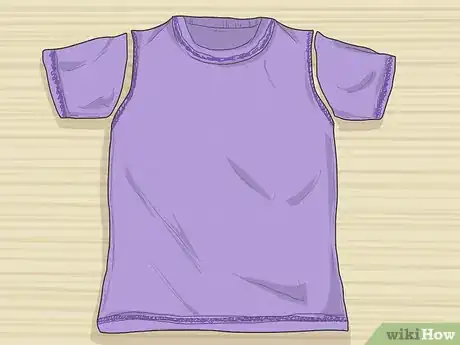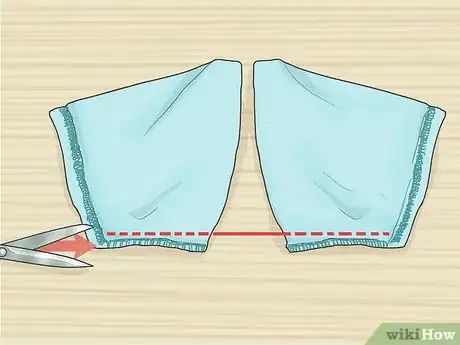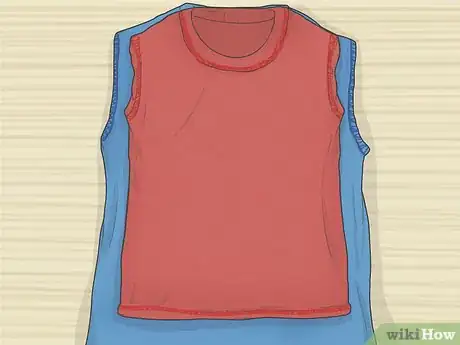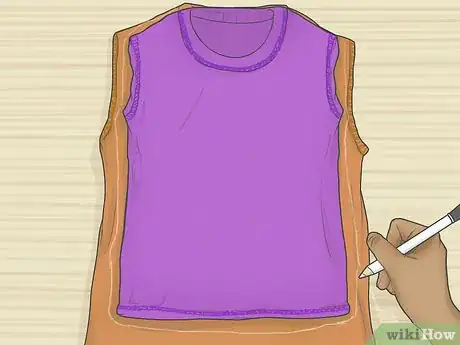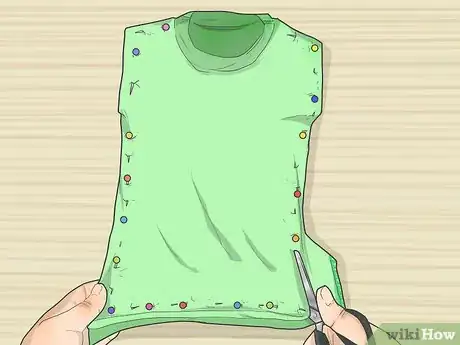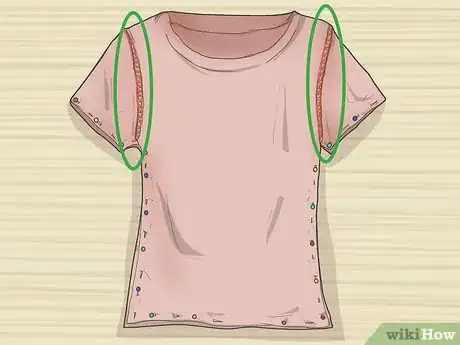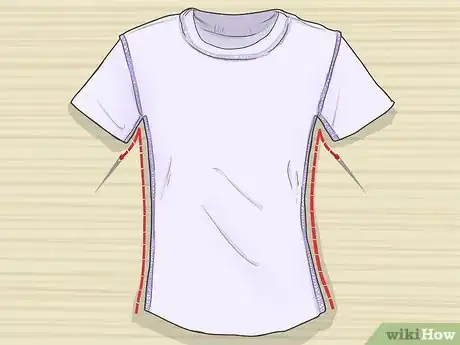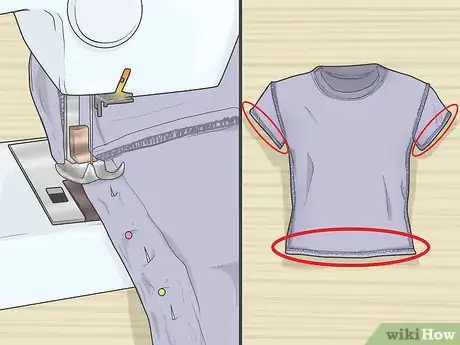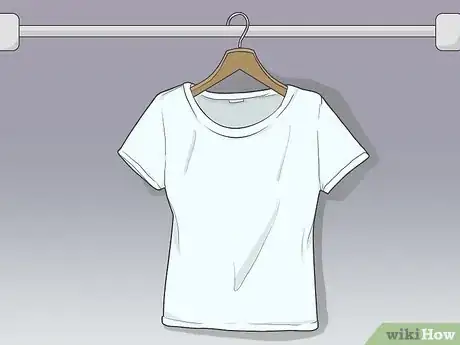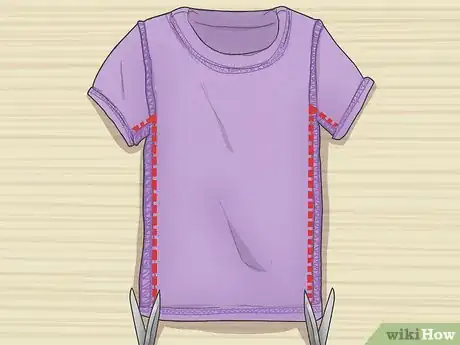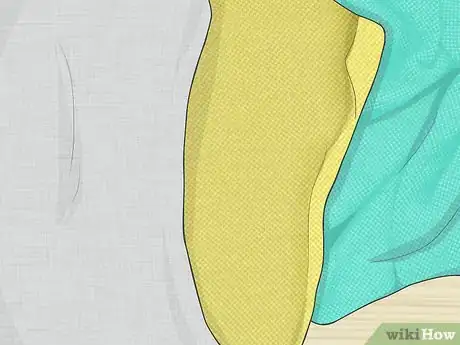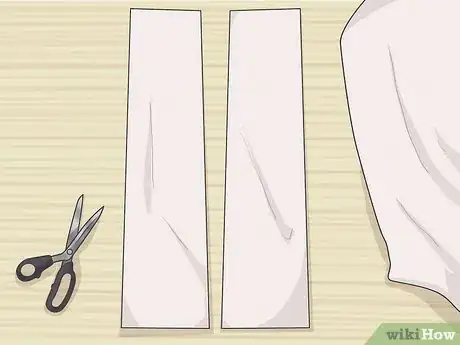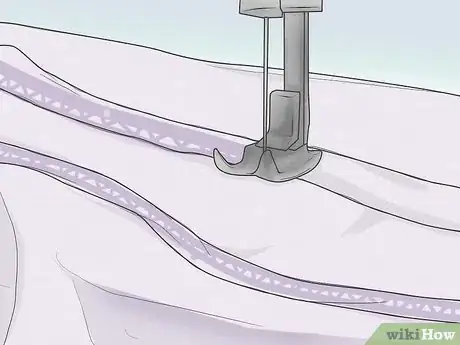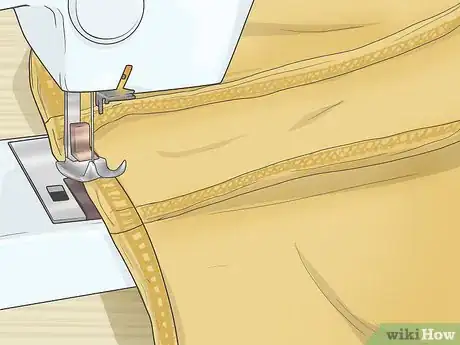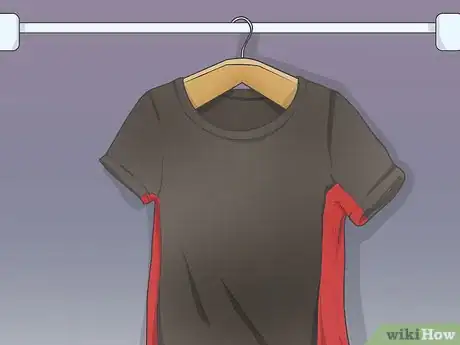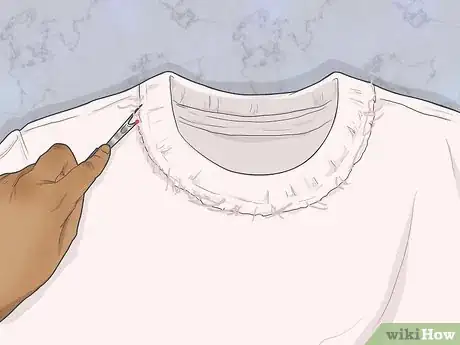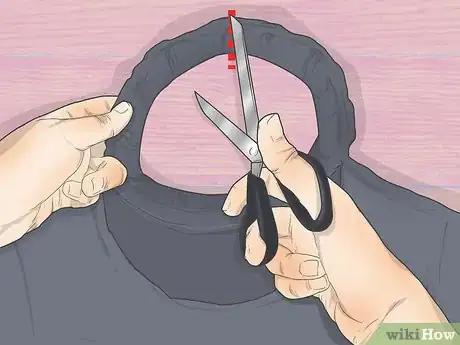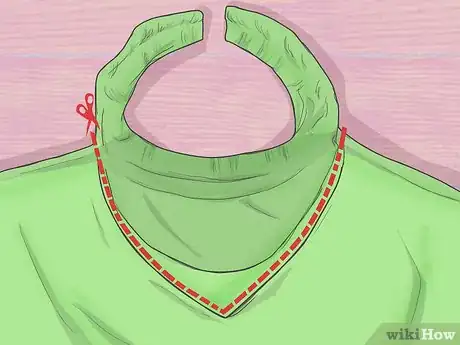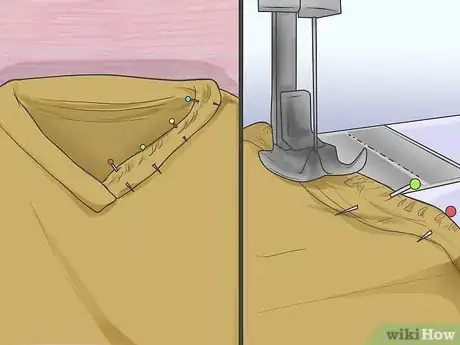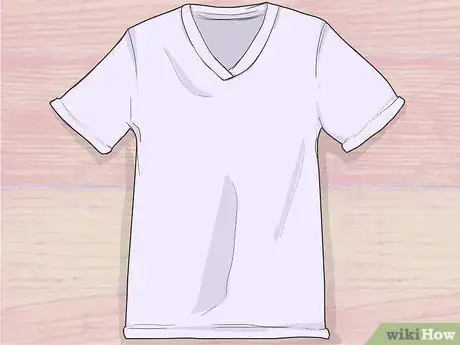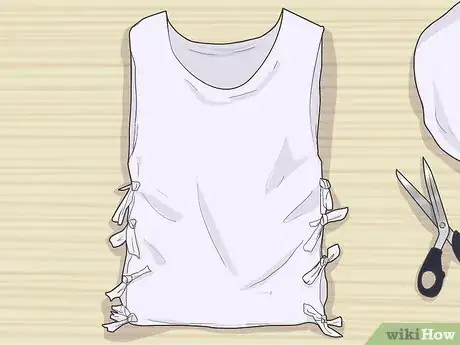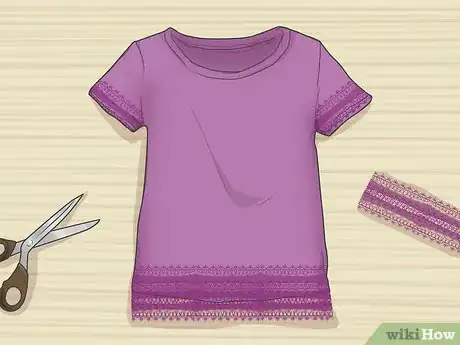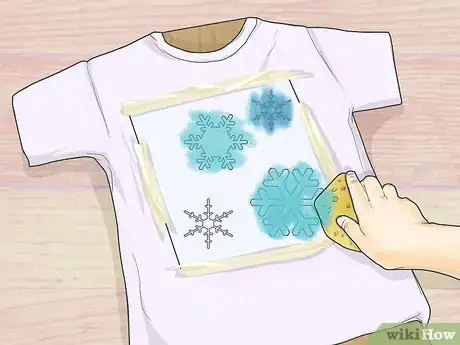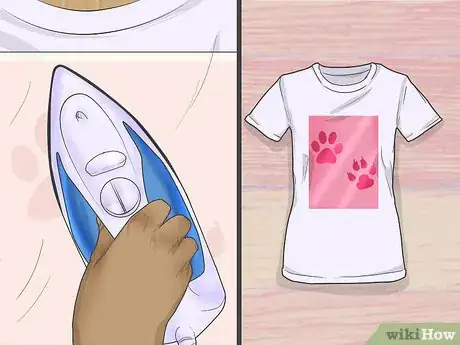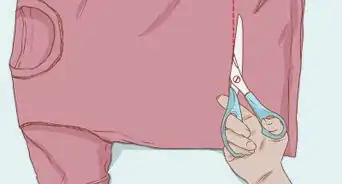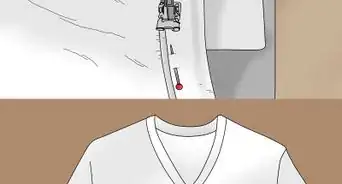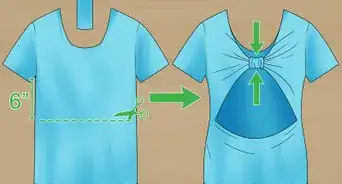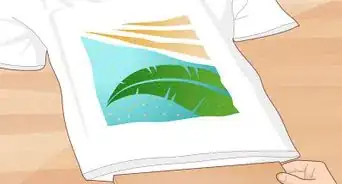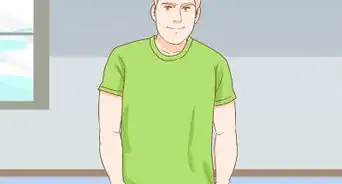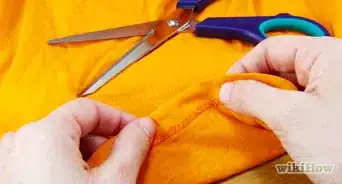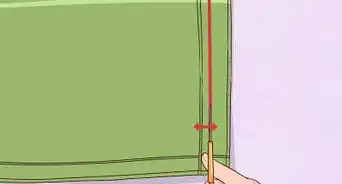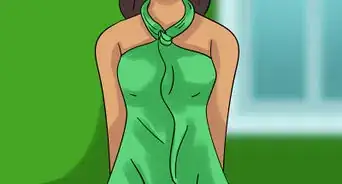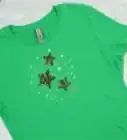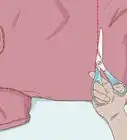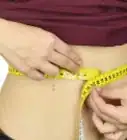This article was co-authored by Joy Cho. Joy Cho is the Founder and Creative Director of the lifestyle brand and design studio, Oh Joy!, founded in 2005 and based in Los Angeles, California. She has authored six books and consulted for creative businesses around the world. Joy has lectured on business, leadership, and entrepreneurship at conferences and companies such as AltSummit, Pinterest, Target, and Hallmark, while her home and studio have been featured in magazines such as House Beautiful, Parents, and Domino. She has also been named one of Time's 30 Most Influential People on the Internet multiple times and has the most followed account on Pinterest with more than 14 million followers.
There are 11 references cited in this article, which can be found at the bottom of the page.
This article has been viewed 1,098,478 times.
Turn an old t-shirt into something new by changing its size, either through adding fabric or cropping, or by redecorating it with personalized stencils, iron-on appliqués, and dyes. Upcycling your clothes is a great way to get new looks while being environmentally conscious cost-effective. The best part is that you don't need to be a trained fashion designer to transform the clothes in your closet. So if you have Simply adding and removing fabric to change the size and fit of the shirt, changing its style, and playing around with crafty add-ons are all options you have for this type of fashion recycling.
Steps
Making a Large T-Shirt Smaller
-
1Turn your shirt inside out and cut the sleeves off. Choose a large, baggy t-shirt that you want to modify. Turn it inside out, then cut the sleeves off right at the seams, so that the original seam is still attached to the body of the shirt.[1]
-
2Cut the sleeves apart at the seams. Flatten the sleeves first, then cut the entire seam off. Leave the hem on and set the sleeves aside.[2]Advertisement
-
3Choose a shirt that fits you, then set it on top of the bigger shirt. Turn the smaller shirt inside out first, then tuck the sleeves in so that they are out of the way. Set the smaller shirt down on top of the bigger one. Make sure that the collars and shoulders match up.
- Make sure that the front of both shirts is facing up.
- You can also use a fitted t-shirt or a sleeveless shirt for this.
-
4Trace around the smaller shirt, adding seam allowances. You'll need to trace around the armholes and the sides of the smaller shirt. Be sure to add a ½ inch (1.27-centimeter) seam allowance.[3]
- It is best to use a dressmaker's pen (light colors) or a dressmaker's chalk (dark colors) for this. If you can't find one, use a washable pen.
- If the bigger shirt is too long, you'll need to trace 1 inch (2.54 centimeters) below the smaller shirt as well.
-
5Pin the bigger shirt, then cut it. Set aside the smaller shirt, then pin the larger one, just inside the lines that you drew. Cut the shirt with sharp fabric scissors, following the lines that you drew. Remove the pins when you are done, but keep them handy for a later step.[4]
- The pins are there to keep the fabric from slipping around while cutting the shirt.
-
6Pin and sew the sleeves onto the shirt. Open up the shirt and the sleeves. Pin the sleeves to the shoulders with the right sides facing in. Sew the sleeves to the shoulders using a matching thread color, a ½-inch (1.27-centimeter) seam allowance and a stretch stitch. Remove the pins as you sew.[5]
- Backstitch at the start and end of your sewing to make it stronger.
- Trim the sleeves down if they are too wide for the shirt.
-
7Sew the side seams on the shirt and sleeves. Flatten the shirt so that the seams on the sleeves and sides match up. Sew it using a matching thread color, a ½-inch (1.27-centimeter) seam allowance, and a stretch stitch. Start sewing at the sleeve hem, and finish sewing at the bottom hem of the shirt.[6]
- Remember to backstitch at the start and end of your sewing.
- Use sewing pins to hold the shirt together, if needed, but remember to take them out as you sew.
-
8Hem the sleeves and bottom if needed. Try the shirt on. If the sleeves or hem are too long, make a mark where you want them to end, then take the shirt off. Fold the sleeves/hem down at the mark. Sew using a matching thread color, ½-inch (½7-centimeter) seam allowance, and a stretch stitch. Trim off the excess hem, if needed, as close to the stitching as you can.[7]
- Remember to backstitch at the start and end of your sewing!
- For a more realistic shirt, add a second line of stitching just below the first one.
- Begin and finish sewing at a seam, not the middle of the hem. This will help disguise the backstitching.
-
9Trim off the excess threads, then turn the shirt right-side out. After this, your new shirt is ready to wear! You don't need to serge the seams on the inside of the shirt because the material does not fray. You can, however, trim the seams down to make them narrower.
Making a Tight T-Shirt Looser
-
1Choose a shirt to modify. This method only works for shirts that are too tight, and within reason. The shirt still needs to fit you reasonably well at the shoulders. While it is possible to make a small shirt bigger, there is only so much you can do.
-
2Turn the shirt inside out and cut it apart at the seams. Flatten the shirt first, then cut the seams off, starting at the bottom hem and finishing at the sleeve. You want to cut the side hems on the sleeves off as well, but leave the sleeves attached to the shirt.[8]
-
3Find a suitable material for the side panels. You will be using this material to fill in the gaps on the sides of the shirt as well as on the underside of the sleeves. Use a matching jersey material, preferably from a matching shirt; if you can't find any, you can buy some from the fabric store.[9]
- Having trouble finding the exact color? Consider a contrasting color! If the shirt has a print on it, match the color to that.
-
4Cut the material into a tapering rectangle to fill in the gap. Use a measuring tape to measure from the edge of the sleeve to the armpit of the shirt, then down to the hem. Cut two rectangles based on that measurement. Plan on making the rectangles 6 inches (15.24 centimeters) on the bottom and 5 inches (12.7 centimeters) at the top.[10]
- If you cut the material from another shirt, make the bottom hem the 6-inch (15.24-centimeter) wide edge. Add 1-inch (2.54 centimeters) to the overall length for hem allowances.
- If you cut the material from store-bought fabric, add 2 inches (5.08 centimeters) to the overall length for hem allowances.
- You can cut the panels wider/narrower to suit your needs.
-
5Pin the panels to the shirt. Turn the panels and the shirt so that the wrong sides are facing out. Pin the front and back left side edges of the shirt to the side edges of your first panel. Make sure that you are pinning the cut edges of the sleeve to the panel as well. Repeat this step for the right side and second panel.[11]
- If you cut the panels from an existing shirt, make sure that the bottom hems match up.
- If you cut the panels from store-bought fabric, leave an even amount of panel sticking out of the sleeve and bottom hems.
-
6Sew the panels to the shirt. Start sewing at the bottom hem and finish sewing at the edge of the sleeve. Use a ½-inch (1.27-centimeter) seam allowance, a stretch stitch, and a matching thread color. Remove the pins as you sew.[12]
- Backstitch at the start and end of your sewing. This will make the seams stronger.
-
7Hem the panels. Fold the edges down on the top and bottom of each panel until they match up with the existing hems on the sleeves and shirt. Pin them in place, then sew them down. You will need to adjust your seam allowances to match those on the existing hems. In most cases, you'll need to sew two rows of stitching. Remove the pins when you are done, then trim off the excess material, as close to the stitching as you can.
- Backstitch at the start and end of your sewing.
- If you cut the material from an existing shirt, you'll only need to do the hem on the sleeve.
-
8Add the final touches, then turn the shirt right-side-out. Go over the shirt, and snip off any excess, hanging threads. If you want to, you can cut the collar of the shirt off as well. You can leave the collar raw for a trendy look, of you can hem it.[13]
- You don't need to finish the inside seams, but you can trim them down to make them narrower.
Turning a Crew Neck into a V-Neck
-
1Use a seam ripper to remove the front part of the collar. You only need to remove the collar from the front of the shirt. When you reach the shoulders, stop; leave the back of the collar intact.[14]
-
2Snip the collar apart in the middle. Find the middle of the collar, then cut it. You will end up with two straps on either side of the shirt.[15]
-
3Cut a V into the front of the shirt. Use the straps from the original collar as a guide so that you don't cut the V too deep. It's okay if you stretch the straps a little, but not too much. The V needs to start at the left edge of the collar, and finish at the right.[16]
-
4Pin the left side of the collar down first. Make sure that you are pinning the collar face-down, with the folded edge facing downward, and the raw edge facing up. You will eventually turn the collar up to hide the seam.[17]
- Pull the collar enough so that it extends to the right side of the collar by ¼ to ½ inch (0.64 to 1.27-centimeters).
-
5Fold the end of the collar until it lines up with the bottom of the V. Depending on how much you extended it by, this will be between ¼ and ½ inch (0.64 and 1.27 centimeters). Secure the fold with a pin, if needed.[18]
- Folding the end of the collar will create a neat seam on the front.
-
6Sew the collar down. Begin sewing at the shoulder and finish sewing at the bottom of the V; adjust the folded end, if needed. Use a ¼-inch (0.64-centimeter) seam allowance, a matching thread color, and a stretch stitch.[19]
- Backstitch at the start and end of your sewing for extra strength.
- Remove the pins as you sew.
-
7Pin and sew the right side of the collar. Pin the right side of the collar, making sure to overlap the left side. Sew it using a ¼-inch (0.64-centimeter) seam allowance, a matching thread color, and a stretch stitch. Remove the pins when you are done.[20]
- There is no need to fold down the end of the collar for this side.
- Remember to backstitch at the start and end of your sewing.
-
8Hand-sew the end of the right collar down. Use a needle and a matching thread color for this. Make sure that you sew through both layers on the right collar, and only one layer on the left collar. This way, you won't see the stitching on the front.[21]
-
9Fold the collar up and press it flat. Fold the collar up so that it sits naturally, like a regular shirt collar. Tuck the hem down so that it is pressed against the shirt material. Iron the collar using the cotton setting on your iron.
Modifying in Other Ways
-
1Cut the collar off to make it a scoop neck. Trace around the front collar, adding 2 inches (5.08 centimeters) on the sides and 1 inch (2.54 centimeters) to the bottom. Flip the shirt over, and trace along the back collar, adding 1 inch (2.54 centimeters) all around. Cut along the lines that you drew.[22]
- You can leave the edges raw, or hem them for a neater finish.
-
2Create a side-tied shirt. Cut the side seams off of a t-shirt, from bottom hem to armpit. Cut 2-inch (5.08-centimeter) slits into the sides of the shirt, 1 to 2 inches (2.54 to 5.08 centimeters) apart. Tug on the tassels to stretch them. Tie each front tassel to the matching back tassel in a tight, double-knot.[23]
- Cut through both the front and back layers of the shirt at the same time so that the slits are even.
- Cut the collar off to make it a scoop neck if desired.
-
3Extend a short t-shirt with lace. Cut enough lace to wrap around the hem of your shirt, plus an added 4 inches (10.16 centimeters), then cut the lace in half. Tuck each piece of lace into the shirt by ½ inch (1.27-centimeters). Pin one piece to the front hem and the other piece to the back hem; overlap the side edges by 1 inch (2.54 centimeters). Sew the lace down, following the original stitching on the shirt.
-
4Tie dye a shirt for a burst of color. Wash the shirt first, but don't dry it. Bundle it up, then wrap rubber bands around it. Mix up a batch of fabric, then apply it to the shirt using a plastic squeeze bottle. Leave the shirt in a plastic, zippered bag for several hours. Rinse the shirt with cold water, then undo the ties and rinse it with warm water.[26]
- Skip the bundling and rubber bands, and dip-dye the shirt for an ombre look.
-
5Stencil a shirt with fabric paint. Tuck a piece of cardboard inside your shirt. Place a stencil on top and secure it with tape, if needed. Apply fabric paint using a sponge brush; work your way from the edges of the stencil inward. Let the paint dry, then peel the stencil away.[27]
- For a trendier look, use fabric spray paint instead.
- For something more unique, use bleach spray.[28]
- Create your own stencils using freezer paper.
-
6Try an iron-on transfer. Purchase a pre-made iron-on transfer design, or print your own using a printer and blank iron-on transfer paper. Cut the design out, place it face-down on your shirt, and iron it following the instructions on the package. Peel the transfer paper away, then wear the shirt!
- If you are printing out your own design, remember to reverse it first!
- Follow the directions on the iron-on packet very clearly and make sure that your shirt is pre-washed to prevent the print from coming off.
- Hold and press the iron on the iron-on transfer and apply constant heat to the iron-on transfer.
Community Q&A
-
QuestionHow do I make a long shirt look good?
 Community AnswerTrim the bottom for a crop top, fringe the bottom and tie it or wear it with black leggings and boots in the fall and early spring.
Community AnswerTrim the bottom for a crop top, fringe the bottom and tie it or wear it with black leggings and boots in the fall and early spring. -
QuestionHow would I style a tee without sewing?
 Community AnswerYou could use iron-on transfers. They look good and could also fix any holes or cover up stains.
Community AnswerYou could use iron-on transfers. They look good and could also fix any holes or cover up stains. -
QuestionIs there a way to pull up (ruche) both sides of the tee shirt to give the bottom hem a draped look?
 Community AnswerTurn the shirt inside out, then sew down both of the side seams using a straight stitch. Pull on the thread to gather it, then knot it off. Turn the shirt right-side-out when you are done.
Community AnswerTurn the shirt inside out, then sew down both of the side seams using a straight stitch. Pull on the thread to gather it, then knot it off. Turn the shirt right-side-out when you are done.
Things You'll Need
Making a Large T-Shirt Smaller
- T-shirt
- Shirt that fits you
- Dressmaker's chalk or pen
- Fabric scissors
- Sewing pins
- Thread
- Sewing machine
Making a Tight T-Shirt Looser
- T-shirt
- Matching jersey material
- Measuring tape
- Fabric scissors
- Sewing pins
- Thread
- Sewing machine
Turning a Crew Neck into a V-Neck
- T-shirt
- Fabric scissors
- Sewing pins
- Needle
- Thread
- Sewing machine
References
- ↑ http://mellysews.com/2011/09/how-to-make-t-shirt-smaller.html
- ↑ http://mellysews.com/2011/09/how-to-make-t-shirt-smaller.html
- ↑ http://mellysews.com/2011/09/how-to-make-t-shirt-smaller.html
- ↑ http://www.andreasteed.com/node/1266
- ↑ http://mellysews.com/2011/09/how-to-make-t-shirt-smaller.html
- ↑ http://mellysews.com/2011/09/how-to-make-t-shirt-smaller.html
- ↑ http://www.andreasteed.com/node/1266
- ↑ https://www.theshabbycreekcottage.com/how-to-make-a-t-shirt-bigger.html
- ↑ https://www.theshabbycreekcottage.com/how-to-make-a-t-shirt-bigger.html
- ↑ https://www.theshabbycreekcottage.com/how-to-make-a-t-shirt-bigger.html
- ↑ https://www.theshabbycreekcottage.com/how-to-make-a-t-shirt-bigger.html
- ↑ https://www.theshabbycreekcottage.com/how-to-make-a-t-shirt-bigger.html
- ↑ https://www.theshabbycreekcottage.com/how-to-make-a-t-shirt-bigger.html
- ↑ https://www.youtube.com/watch?v=lZWs58mhuOc
- ↑ https://www.youtube.com/watch?v=lZWs58mhuOc
- ↑ https://www.youtube.com/watch?v=lZWs58mhuOc
- ↑ https://www.youtube.com/watch?v=lZWs58mhuOc
- ↑ https://www.youtube.com/watch?v=lZWs58mhuOc
- ↑ https://www.youtube.com/watch?v=lZWs58mhuOc
- ↑ https://www.youtube.com/watch?v=lZWs58mhuOc
- ↑ https://www.youtube.com/watch?v=lZWs58mhuOc
- ↑ https://www.youtube.com/watch?v=zPjJ3O2DS5o
- ↑ http://geekandsundry.com/transform-schlumpy-swag-into-geek-chic-with-these-diy-t-shirt-mods/
- ↑ https://www.trinketsinbloom.com/diy-lace-edged-t-shirt/
- ↑ http://www.polkadotchair.com/2013/07/diy-lace-sleeved-t-shirt.html/
- ↑ http://www.dharmatrading.com/techniques/tiedye/tie-dye-instructions.html
- ↑ http://prettyprovidence.com/diy-freezer-paper-stencil-shirt/
- ↑ http://www.practicallyfunctional.com/diy-bleach-spray-shirt/
About This Article
To modify a T-shirt to make it cuter, try cutting the collar off to make a scoop neck. First, trace around the front collar with 2 inches added to the sides and 1 inch on the bottom. Cut along the lines you drew and either leave the edges raw or hem them for a neater finish. Another way to modify a shirt is to make side tassels. Start by cutting the side seam from the bottom hem to the armpit. Then, cut 2-inch slits into the sides of the shirt 1 to 2 inches apart and tie your tassels together. If you want to lengthen a short t-shirt, wrap lace around the hem and sew it into place. To learn how to stencil a shirt with fabric paint, keep reading!
